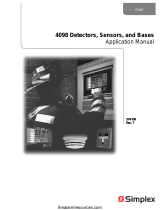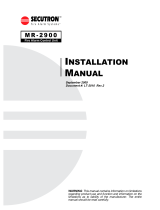
When the RR-2 is used and the control function is critical,
no more than one DI-4A should be installed in a particular
circuit or zone, and no other initiating devices should be
installed in that same circuit or zone. An exception to this
rule would be an application where a number of RR-2
relays were used, each of which was connected to the
same critical control function.
Mounting Data
The DI-4A detector utilizes either a flush or surface mount-
ing base assembly. Each base may be attached to a
standard 4" octagonal electrical box with an adapter
(included) when conduit is used, or may be used without
box when local building codes permit. The DB-4TS base
contains provision for an optional field installed locking
mechanism to prevent unauthorized removal of the
detector head. A flush locking base, Model DB-4TFL, is
also available.
The detector shell and base are fabricated of rugged
polycarbonate material eliminating any corrosion prob-
lems. They are off-white in color and attractively styled to
be unobtrusive and to match most interiors.
By using the Cerberus Pyrotronics sensitivity tester, Model
MG-7/9 the detector can be easily checked for proper
operation.
Application Data
No more than thirty (30) detectors of any type or combina-
tion (other than thermals or manual stations) may be used
on any one Cerberus Pyrotronics detector circuit.
This detector is applicable to the 30-foot center spacing
(900 sq. ft.) as referred to in the National Fire Protection
Association Standard 72. This, however, is based on ideal
conditions, namely, smooth ceiling, no air movement, and
no physical obstructions between the fire source and the
detector. This spacing should be used as a guide or
starting point in detector installation layout. Do not mount
detectors in areas close to ventilating or air conditioning
outlets. Exposed joists or beamed ceilings may also affect
safe spacing limitations for detectors. It is mandatory that
engineering judgment be applied regarding detector
location and spacing.
Engineer and Architect Specifications
The fire detector shall be a Cerberus Pyrotronics Model DI-
4A with adjustable sensitivity. It shall operate on the
ionization principle, activated by the presence of combus-
tion products, and shall be listed by Underwriters Labora-
tories Inc. The detector shall be a plug-in, twist/lock unit
which may be installed in or removed from its base with
one hand.
The detector shall contain two ionization chambers,
amplifier-switching circuit and solid state indicator lamp.
One chamber shall be for fire detection and the second
chamber shall function as a reference, to stabilize the
detector for changes in environmental temperature,
humidity, and pressure. The unit shall contain no operat-
ing moving parts.
The amplifier-switching circuit in the detector shall be
entirely solid state, and shall operate with a detector line
voltage of 20 VDC.
The unit shall be capable of being manually adjusted for
low or high sensitivity. The resulting sensitivity setting shall
be visible through an indicator slot located on the detector
housing. No special tools shall be required to change the
sensitivity setting.
The base assembly into which the detector is installed
shall be of the twist/lock type with screw type terminals,
and shall be a Cerberus Pyrotronics Model DB-4 (Insert TS
or TF). Pigtails or in-line connectors shall not be permitted.
The base shall include a lamp to indicate alarm of the
detector.












